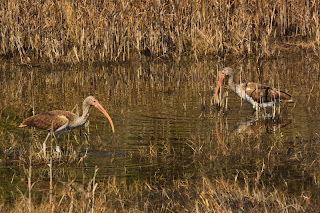We've had sunshine and moderate temperatures for several days now, and everyone here is positively giddy. Walking dogs (and lots of people have them) in cold, windy, weather isn't fun for anyone, except maybe the dogs.
On Saturday, we drove 35 miles east to Aransas National Wildlife Refuge to stretch our legs and see if there were birds and other critters out and about. The spring migration hasn't started yet, so we only saw a few resident birds. The Whooping Cranes were hiding, but we did see several flocks of Long-billed Curlew alongside the road on our way in. There were also graceful White Ibis feeding in marshlands along one of the trails we walked. The White Ibis is a medium-sized wading bird with red face, red legs, and a long decurved bill. In flight the adults like this one are especially striking, with black wing-tips offsetting their snowy feathers. Maybe I'll get a shot of one in flight before we leave.
On Saturday, we drove 35 miles east to Aransas National Wildlife Refuge to stretch our legs and see if there were birds and other critters out and about. The spring migration hasn't started yet, so we only saw a few resident birds. The Whooping Cranes were hiding, but we did see several flocks of Long-billed Curlew alongside the road on our way in. There were also graceful White Ibis feeding in marshlands along one of the trails we walked. The White Ibis is a medium-sized wading bird with red face, red legs, and a long decurved bill. In flight the adults like this one are especially striking, with black wing-tips offsetting their snowy feathers. Maybe I'll get a shot of one in flight before we leave.
The splotchy brown Ibis are juveniles. We almost missed the one on the bank because it so perfectly camouflaged.
We also saw a number of these small, sparrow-like birds. They should be called a Yellow-rumped Something or Other. However, so far I haven't been able to find them in my Peterson Field Guide. I'll let you know when I identify them.
A raccoon skittered along the edge of the pond but didn't come out for photographs and we also spied an armadillo. When we rounded a turn in the path and surprised one of these iconic Texas critters, the dogs almost pulled me off my feet. Fortunately I was able to stop them before we all disappeared into the bushes after the 'dillo.
Aransas also has a healthy population of American Alligators. We were advised to keep all pets on leash, and I understand why. As we walked the trails we saw these two 'gators, which we estimated to be about 10 feet long.
We didn't have to drive all the way to the wildlife refuge to see birds, though. Right in our RV park is a sizable flock of Black-bellied Tree Ducks, also known as Black-bellied Whistling Ducks. We see them beside the ponds and on the water during the day. Then, as the sun sets they take off and soar overhead in shrilly-whistling "V" formations. As you can see in this photo, they have long pink legs and a coral-pink bill.
The ponds at Bay View have signs warning us to watch out for alligators. We were told that at least 18 were removed from the park a couple of years ago after they threatened guests and their pets. So far as we can see, there are no more in residence, thank goodness! However, we'll keep the dogs out of the water just the same.







No comments:
Post a Comment